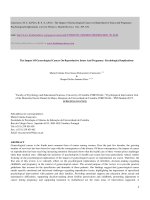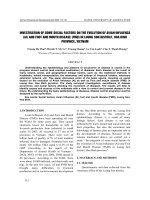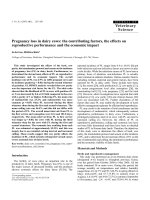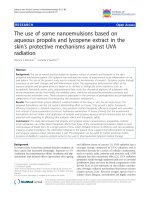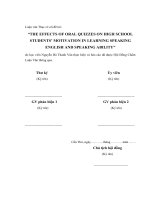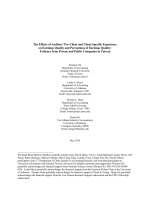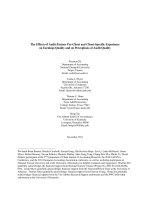EFFECTS OF SOME TECHNICAL FACTORS ON REPRODUCTIVE PERFORMANCES AND RESULTED SEED PRODUCTION OF SNUBNOSE POMPANO (trachinotus blochii lacepede, 1801) IN KHANH HOA
Bạn đang xem bản rút gọn của tài liệu. Xem và tải ngay bản đầy đủ của tài liệu tại đây (130.02 KB, 23 trang )
MINISTRY OF EDUCATION AND TRAINING
NHA TRANG UNIVERSITY
------------oo0oo-----------
NGO VAN MANH
EFFECTS OF SOME TECHNICAL FACTORS ON
REPRODUCTIVE PERFORMANCES AND RESULTED SEED
PRODUCTION OF SNUBNOSE POMPANO (Trachinotus blochii
Lacepede, 1801) IN KHANH HOA
Major code: Aquaculture
Code: 62620301
SUMMARY OF DOCTORAL THESIS
KHANH HOA – 2015
Research was accomplished at Nha Trang University
Supervisors:
1. Associate Prof. PhD Lai Van Hung
2. PhD. Ngo Anh Tuan
Referee 1: Associate Prof. PhD Do Van Khuong
Hai Phong Research Institute for Marine Fisheries
Referee 2: PhD. Truong Ha Phuong
Research Institute for Aquaculture No. 3
Referee 3:
PhD. Huynh Minh Sang
Institute of Oceanography
The thesis was defended at the committee of doctorate thesis examiners of
Aquaculture Institute in Nha Trang University at …….., ………, ……… 2015
The thesis can be found at:
National Library of Vietnam
The Library of Nha Trang University
INTRODUCTION
The snubnose pompano (Trachinotus blochii) is a pelagic fish and able to
tolerate a wide range of salinities. It has become an important marine fish at many
countries in Asian Pacific Ocean due to high market price, available culture
techniques. Many studies had been conducted on reproduction and grow-out culture of
this species. However, the current problems relating to the low maturity, low fertilized
and hatching rates as well as fluctuated survival rate and high deformity of early larvae
has not been paid adequate attentions.
Many studies have indicated the influence of egg and larval quality on seed
production. This may be attributed by aspects of the broodstock nutrition. The diets
containing available n-3 HUFA, vitamin E and astaxanthin play important roles in
gonadal development and quality. In addition, the applications of new technical
advances in fish reproduction including feeding regime, stocking density, nutrient
supplementation as well as photoperiod to enhance the efficiency of rearing efficiency
also evaluated in some marine fish species such as European sea bass, barramundi.
Therefore, it is important to continuously solve the current problems to improve
reproductive effeciency of snubnose pompano. Acording to these reasons, the thesis
“Effects of some technical factors on reproductive performances and resulted
seed production of snubnose pompano (Trachinotus blochii Lacepede, 1801) in
Khanh Hoa » was conducted.
Objectives:
-
General objective: Provide new techniques in reproduction of snubnose pompano.
-
Particular objective: Improve the fecundity, egg and larval quality as well as
juvenile rearing efficiency.
The main contents:
1. Effects of different trash fish, feeding rations and vitamin E levels fed to snubnose
pompano broodstocks on reproductive efficiency in terms of fecundity, egg and
larval quality.
2. Effects of different hormones injected to broodstocks on fecundity, egg and larval
quality of snubnose pompano.
3. Efficiency of technical solutions applied in larval and juvenile rearing of snubnose
pompano.
The significances:
-
Scientific significance: This research contributes to the understanding in
reproduction and seed production.
-
Practical significance: The results of the research provide suitable techniques in
snubnose pompano reproduction. The application of these protocols can improve
survival rate and growth performance of snubnose pompano in hatcheries.
Consequently, it also introduces new species for marine finfish aquaculture in
Vietnam.
Findings
-
This is the first publication in nutritial requirement for broodstocks of snubnose
pompano in Vietnam. The study has determined the suitable diets, optimum
feeding ration and vitamin E for broodstocks of snubnose pompano. The suitable
hormones and dose also have been determined to optimize the reproductive
performances of snubnose pompano. The new technical solutions in thee present
study including stocking density, feeding ration, photoperiod and optimum DHA
Protein Selcon enriched concentration are firstly applied to improve the survival,
growth performances of snubnose pompano in Vietnam.
CHAPTER 1 – LITERATURE REVIEW
1.1 Overview of marine fish culture in the world and Vietnam
In 2010, the total production marine fish culture in both marine and brackish
water was 4,429,000 tons, accounting for 19,3% of total production of aquaculture.
The average annual growth rate for brackishwater fish and marine fish aquaculture
production from 1990 to 2010 was 9,3%. The major cultured species were Atlantic
salmon, snapper, European seabass, red drum, milkfish, grouper, barramundi, red
seabream, mullet, turbot, cobia, cod and tuna, in which salmon aquaculture production
was 1.9 00.000 tons. The main producers were China, Norway, Chile, Japan, Greece,
Turkey, Taiwan-China, Philippine, Indonesia and Vietnam.
The marine fish aquaculture in Vietnam started in 1990s in small-scales systems
including cages and earthern ponds in coastal provinces such as Quang Ninh, Hai
Phong, Nghe An and Khanh Hoa, in which grouper, barramundi and cobia and red
snapper were the major cultured species. Although, the successful reproductions of
some marine finfish have been developed, the limitation of seed supply still has not met
the seed demand for marine aquaculture.
The reproduction of snubnose pompano was first developed in Taiwan in 1989,
and then China, Indonesia and Vietnam also achieved the success in reproduction of
this species.
1.2 Biology of snubnose pompano
Snubnose pompano (Trachinotus blochii Lacepede, 1801) is belong to
Carangidae family, the order Perciformes. It mainly distributes in Pacific Ocean,
Atlantic Ocean and Indian Ocean.
Snubnose pompano is omnivores, but mostly feed aquatic animals with active
feeding. Snubnose pompano has fast growth rate. Juvenile (19 – 26 g) can grow to 608
– 610 g after 5 months.
The breeding season of snubnose pompano was from March to October, and
independent with the fullmoon. The fecundity of this species ranges from 38.000 –
122.000 eggs/kg female.
1.3 The maturity and spawning of teleost fish.
The reproductive biology varied in fish species to adapt to the environmental
conditions. For example, the Pacific salmon only spawn once before death, while
many other species can spawn many times during their life. Many species usually
build nests for spawning and egg protection, while the changes in reproductive
characteristics including increase in fecundity, reproduce several times per year are
observed in unprotected egg species.
The available foods and environmental conditions play important roles in fish
reproduction. Fish can perceive and utilize seasonal variations in environmental
factors such as photoperiod, temperature, moon phase, water flowing and water
pressure to ensure reproductive success during suitable periods of the year.
The breeding cycle is controlled by hormones produced from pituitary gland
and gonad, in which gonadotropic hormone (GTH), follicle- stimulating hormone
(FSH) and luteinizing hormone (LH) play important roles.
1.4 The overview on nutrional requirements of broodstock and young juvniles
The broodstock nutrition management plays important role in improvement the
quality of eggs and larvae, determining the success of marine fish reproduction.
The available foods with good quality play crucial roles in survival and
development of larvae. Thus, the understanding in nutritional requirement, digestive
development and suitable feeding regimes is particularly important in the development
of early larvae.
1.5 The effects of induced hormone on reproductive performance of fish
The determination of hormone injections or adjusting the ecological factors
changes in each fish, depending on the reproductive biology, maturity. Currently, there
are several types of hormones including LHRHa, ovaprim, pituitary gland, HCG, PMS
used in fish reproduction with different advantages and disadvantages effects.
Many studies has evaluated the effects of hormones on the fecundity, time to
spawn of broodstocks, while the knowledge on the reproductive cycles, the quality of
egg and larvae affected by hormones is still unknown.
1.6 The effects of stocking density, diets and photoperiod on growth performances
of young juveniles
In juvenile stage, the high stocking density may leads in the competition for
food and living space, resulting in low survival and high coefficient variation. Besides,
other factors such as diet, water- flow, color tanks, light and diseases also affect the
growth, survival and feeding behavior of juveniles.
CHAPTER 2. MATERIALS AND METHODS
2.1. Species, time and location of research
-
Species: Snubnose pompano (Trachinotus blochii Lacepede, 1801)
-
Duration: June 2009 – June 2013
-
Location: All experiments for broodstocks were conducted in Marine fish
aquaculture station, located in Nha Trang bay, Khanh Hoa, whereas the trials for
larvae and juvenile were carried out in Duong De marine seed production hatchery
in Nha Trang, Khanh Hoa.
2. 2. Contents
Evaluating the effects of technical solutions on eggs, larvae quality and juvenile rearing efficiency
of snubnose pompano in Khanh Hoa province
Effects of different trash
fish, feeding rations and
vitamin E levels fed to
broodstocks
on
fecundity, egg and larval
quality of snubnose
pompano
Effects of different
hormones injected
to broodstocks on
fecundity, egg and
larval quality of
snubnose
pompano.
Evaluated parameters:
- Reproductive
performance
(maturity,
fecundity).
- Thời gian tái phát dục, thời gian hiệu ứng
thuốc
- Egg quality (Egg diameter, ferlilized rate and
hatching rate).
- Larval quality (larval size, deformity, survival
rate).
Evaluating some technical solutions on
improvement of seed production
From larvae to fry
- Effects of the stocking density
- Effects of live feed with DHA
Protein Selco enrichment
- Effects of weaning time to micro
diets
- Effects of the photoperiod
From fry to juvenile
- Effects of the stocking density
- Effects of the feeding rations
- Effects of the photoperiod and
feeding frequency.
Evaluations and conclusions
Figure 2.1: Diagram of the research
2.3 Materials and methods
2.3.1 Broodstock
Broodstocks used in this study were selected from grow-out cages, at average
weight of 2,2 – 3,7 kg.
The first trial: Effects of different trash fish diets for broodstock on egg and
larval quality of snubnose pompano.
Broodstock were stocked in 4 cages (21fish/cage) and fed 4 different diets
including 100% fish (NT1); 70% fish: 15% squid: 15% shrimp (NT2); 70% fish: 30%
squid (NT3) and 70% fish: 30% shrimp (NT4). All diets were sampled for proximate
composition and fatty acids analysis before feeding experiment commenced. The
fecundity, egg diameter, floated egg, fatty acid profile in egg, fertilized, hatching rate,
larval size, deformity and survival rate of larvae three day after hatching were
evaluated to determine the suitable diet for broodstocks.
The second trial: Effects of feeding ration fed for broodstocks on reproductive
performances of snubnose pompano.
Based on the results in the first trial, the broodstocks in this experiment were
fed diet containing at 4 feeding ratios: 5% (NT1); 7% (NT2); 9% (NT3) and 11%
(NT4). The broodstock, cages, stocking density were similar as descriptions in the first
trial. The fecundity, egg diameter, floated egg rate, fatty acid profile in egg, fertilized
rate, hatching rate, larval size, deformity and survival rate of larvae three day after
hatching were evaluated to determine the suitable feeding ration for broodstocks.
The third trial: Effects of vitamin E supplementation in diet fed for broodstocks
on reproductive performances of snubnose pompano.
In this trial, all broodstocks were fed with 5 levels of vitamin E supplementing:
0 mg/kg (NT1); 250 mg/kg (NT2); 500 mg/kg (NT3); 750 mg/kg (NT4) and 1.000
mg/kg (NT5). The feeding ration was 9 % body weight based on results of the second
trial. The broodstock, cages, stocking density were similar as descriptions in the first
trial. The fecundity, egg diameter, floated egg rate, fatty acid profile in egg, fertilized
rate, hatching rate, larval size, deformity and survival rate of larvae three day after
hatching were evaluated to determine the optimum dietary vitamin E for broodstocks.
The fourth trial: Effects of induced hormones on reproductive performances of
snubnose pompano
Broodstocks were fed diet containing 70% fish: 15% squid and 15% shrimp
with 750 mg/kg vitamin E supplementing at feeding ration of 9% body weight.
Broodstocks were injected different hormones including 50 µg LRHa + 5 mg DOM/kg
(NT1); 1200 IU HCG/kg (NT2); 500 IU HCG + 40 µg LRHa/kg (NT3); Common carp
pituitary of 10 mg/kg (NT4) and saline water at 0,5 mL/kg (NT5). The fecundity, egg
diameter, floated egg rate, fertilized rate, hatching rate, larval size, deformity and
survival rate of larvae three day after hatching were evaluated to determine the suitable
hormone for reproduction. The broodstock, cages, stocking density were similar as
descriptions in the first trial.
2.3.3 Methods used in 3rd content.
2.3.3.1 Larvae
Fertilized eggs were obtained from reproduction in Vung Ngan station, and then
tranferred to Duong De marine seed production hatchery for incubation. Newly
hatching larvae were selected and used for experiments.
The fifth trial: Effects of stocking densisty on growth, survival and deformity of
snubnose pompano larvae.
Satge 1: From newly hatched larvae to 23rd days old
The larvae were randomly distributed to twelve 100-L fiber-glass tanks with 4
stocking densities including 15, 30, 45 and 60 larvae/L. Each experimental density was
assigned to three randomly positioned tanks. The survival rate, growth rate, deformity
of larvae were evaluatetd after 23 days of experimental period.
Stage 2: From fry to juvenile
The fry ( average length 19,22 ± 1,63 mm and weight 0,42 ± 0,03g) were
selected from previous trials and randomly distributed to twenty four 70-L fiber-glass
tanks with 8 stocking densities including: 1,0; 1,5; 2,0; 2,5; 3,0; 3,5; 4,0 and 4,5
inds/L. Each experimental density was assigned to three randomly positioned tanks.
The survival rate, growth rate, deformity and feed conversion ratio were evaluatetd
after 28 days of experimental period.
The sixth trial: Effects of DHA Protein Selco levels in live feed on growth
performances and shock resistance of snubnose pompano larvae.
The larvae were randomly distributed to thirty two 100-L fiber-glass tanks at
the stocking density of 40 larvae per tank. Fish was fed live feed contained DHA
Protein Selco enrichment with 8 concentrations: 0, 50, 100, 150, 200, 250, 300 and
350 ppm. The survival rate, growth rate, deformity and shock resistance to temperature
and salinity shocks were evaluatetd after 33 days of the feding period. Whereas the
resistance to mechanical shock was evaluated after 23 and 33 days of the feeding
period.
The seventh trial: Effects of weaning time to commercial diet on growth
performances and survival of snubnose pompano fry.
The newly hatching larvae were cultured in 4 m3 tanks for 12 days and then fish
(average length 4,45 ± 0,81 mm and weight 2,71 ± 0,29 mg)
were randomly
distributed to twenty-one 70-L fiber-glass tanks at the stocking density of 5 ind/L. Fish
was fed a commercial diet (NRD, INVE, Thailand) at 7 different weaning times
including 13, 15, 17, 19, 21, 23, 25 days after hatching. Each treatment was assigned
to three tanks and lasted for 20 days.
The eighth trial: Effects of feeding rations on growth performances and survival of
juvenile snubnose pompano.
Juveniles (35 days after hatching) had average length 19,76 ± 1,23 mm and
weight 0,35 ± 0,04 g were randomly distributed to fifteen 70-L fiber-glass tanks at the
stocking density of 2 inds/L. Fish was fed commercial diet (NRD, INVE, Thailand)
with 5 feeding rations including 3, 6, 9, 12 and 15 % wet body weight. Each treatment
was assigned to three tanks. The survival rate, growth rate, deformity and feed
conversion ratio were evaluatetd after 28 days of experimental period.
The nineth trial: Effects of photoperiods on growth performances and survival of
snubnose pompano larvae.
The larvae were randomly distributed to twelve 100-L fiber-glass tanks at
stocking density of 40 inds/L. The tank was controled with 4 photoperiod regimes
including natural photoperiod 8 hours/day – 8L:16D (NT1); 12L:12D (NT2); 18L:6D
(NT3) and 24L:0D (NT4). Each treatment was assigned to three tanks. The survival
rate, growth rate, deformity were evaluatetd after 25 days of experimental period.
The tenth trial: Effects of photoperiod and feeding frequency on growth
performances and survival of juvenile snubnose pompano.
Juveniles (average length 12,15 ± 1,14 mm and weight 0,12 ± 0,01 g) were
randomly distributed to twenty-four 70-L fiber-glass tanks. Fish was fed 4 feeding
rations (2, 4, 6, 8 times/day) with 2 photoperiod regimes (12 and 18 hours). Each
treatment was assigned to three tanks. The survival rate, growth rate, deformity and
feed conversion ratio were evaluatetd after 28 days of experimental period.
2.4 Parameter calculations
2.4.1 Water quality paramenters
2.4.2 Reproductive characteristics
2.4.3 Growth performances in terms of growth rate, survival, deformity and feed
conversion ratio.
2.4.4 Proximate composition
2.5 Statistical analysis
All data were expressed as mean ± SE and analysed by one-way analysis of
variance (ANOVA) with post hoc Duncan multiple comparison tests by using SPSS
for Windows version 12.0 to evaluate the significant differences among treatments.
Two-way analysis ANOVA with Duncan post hoc test was used to analyse the effects
of different factors and interaction in two factor experiments. The statistical
significance was evaluated at P < 0.05. All charts were drawed using Microsoft Excel.
CHAPTER 3: RESULTS AND DISCUSSIONS
3.1 Effects of different trash fish, feeding rations and vitamin E levels fed to
broodstocks on fecundity, egg and larval quality of snubnose pompano
3.1.1 Effects of different trash fish diets for broodstock on egg and larval quality
of snubnose pompano
3.1.2.1 Maturity and fecundity
Broodstocks fed different diets showed significantly effects on the maturiry (P
< 0.05). The lowest maturity was observed in fish fed CT diet, while the highest
maturity was recorded in fish fed diet containing 70% fish: 15% squid and 15%
shrimp. Different diets also significantly affected (P < 0.05) on the fecundity of
snubnose pompano, where the highest fecundity was reported in broodstocks fed diet
containing raw fish, squid and shrimp. Although, the fecundity of fish fed raw fish
with squid supplementing showed the significantly higher than those of fish fed only
raw fish diet, it still was significantly lower than the fecundity of fish fed diet
containing raw fish and squid and shrimp supplementation.
3.1.2.2 Egg quality
Crude lipid and fatty acid profile
There were no effects (P > 0.05) of different diets fed to broodstocks on the
lipid content, saturated fatty acid and mono unsaturated fatty acid profiles in egg of
snubnose pompano, where crude lipid ranged from 11,65 – 12,63% in dry weight
basic, saturated fatty acids was from 1,42 to 1,77%, and mono unsaturated fatty acids
were 1,31 to 1,68%. The PUFA (2,39 -2,42%) and HUFA (1,63 – 1,71%)
concentrations in eggs of fish fed diets containing raw fish and squid supplementing
were significantly higher than those of fish fed diets containing raw fish or raw fish
with shrimp supplementation (P < 0.05).
The DHA concentration in eggs of broodstocks fed CT + M and CT + M + T
diets showed significantly higher those of fish fed other diets (P < 0.05). However, no
significant differences were observed in ARA and EPA levels in eggs of broodstocks
fed different diets (P > 0.05). The EPA/ARA, DHA/EPA and n-3/n- 6 ratios were 1,30
- 1,46%; 2,89 – 3,27% and 3,01 – 3,26%, respectively and did not affected tested diets
(P > 0.05).
Egg diameter, floated egg rate, fertilized rate and hatching rate
Broodstocks fed tested diets had no effects on egg diameter and egg’s oil
droplet size (P > 0.05). Egg diameter ranged from 0,98 to 1,00 mm, while oil droplet
was 0,27 – 0,28 mm.
The fertilized rate, floated egg rate and hatching rate were significant affected
by the experimental diets fed to broodstocks (P < 0.05), resulting in highest values in
fish fed diet containing raw fish with squid and shrimp supplementing. The
supplementation of squid or shrimp into broodstocks diets significantly improved the
fertilized rate, floated egg rate compared with those of broodstocks fed raw fish diet
only (Figure 3.3).
Cá tươi
105
Cá tươi-Mực-Tôm
b
b
Tỷ lệ (%)
90
75
a
Cá tươi-Mực
Cá tươi-Tôm
c
a
b
ab b
a
a
ab a
60
45
30
15
0
Trứng thụ tinh
Trứng nổi
Tỷ lệ nở
Figure 3.3: Fertilized rate, floated egg rate and hatching rate of snubnose
pompano fed different diets
Larval quality
The supplementing of shrimp and squid into diet containing raw fish fed to
broodstocks significantly improved early larval size, yolk-sac size and oil droplet size
of snubnose pompano (P < 0.05) (Table 3.1). The lowest deformity rate of larvae was
observed in group fed CT + M+ T or CT +T diets, while the highest deformity rate
was recorded in gourp fed CT diet (P < 0.05). There was no effects of tested diets fed
to broodstocks on the survival rate of 3 days old larvae (P > 0.05).
In summary, the results indicated that broodstocks fed diet containing 70% raw
fish; 15% squid and 15% shrimp can improve the maturity, fecundity as well as egg
and larval quality of snubnose pompano.
3.1.2 Effects of feeding ration fed for broodstocks on reproductive performances
of snubnose pompano
3.1.2.1 Growth performance, maturity and fecundity
The results showed that the feeding rations had significant effect on the growth
rate, maturity and fecundity of snubnose pompano (P < 0.05). The highest maturity
rate (91.49 %) was observed in broodstocks fed ration of 9% body weight, there were
no significant differnces on the maturity rate of fish fed rations of 5, 7 and 11% BW
(P > 0.05). The fecundity rate of broodstocks fed feeding rations of 5, 7 and 11% BW
were 51.822, 74.626 and 77.098 eggs/kg, respectively and significantly lower than that
of fish fed ration of 9% BW.
3.1.2.2 Egg diameter, floated egg, fertilized rate and hatching rate
The egg diameters of fish fed feeding rations of 9 and 11% body weight showed
significantly larger than those of fish fed 5 % ration (P < 0.05). However, there were
no significant effects of feeding rations on oil droplet size, fertilized rate, floated egg
rate and hatching rate of snubnose pompano (P > 0.05).
3.1.2.3 The larval length, deformity and survival of larvae
No significant differences were recorded on larval length, deformity and
survival rate of larvae among groups, where broodstocks were fed different feeding
rations (P > 0.05).
In summary, the increase of feeding ration fed to broodstocks from 5 to 11%
BW did not improve the fertilized rate, hatching rate, deformity and survival rate of
snubnose pompano larvae. But, the growth rate, egg diameter of broodstocks
significantly increased, corresponding with the increase in feeding ration. The feeding
ration of 9% body weight was the optimum level for reproductive performances of
snubnose pompano.
3.1.3 Effects of vitamin E supplementation in diet fed for broodstocks on
reproductive performances of snubnose pompano
3.1.3.1 The maturity and fecundity
The lowest maturity was recorded in broodstocks fed diet without vitamin E
supplementing, and significantly lower than those fed diet with vitamin E
supplemented levels (P < 0.05). The lowest and highest maturity of males were
observed in fish fed diets without and 750 mg vitamin E supplementing, respectively.
No significant differences were found on the maturity of males fed diets with 250, 500
and 1000 mg vitamin E supplementations.
The similar results also were observed in the maturity of females, resulting in
high maturity in fish fed diets with vitamin E supplementing compared with those fed
diet without vitamin E supplementation (P > 0.05).
3.1.3.2 Egg quality
The vitamin E supplemented levels on broodstock diets had no significant
effects on egg diameters, oil droplet and floated egg (P > 0.05). However, the fertilized
and hatching rate significantly improved in fish fed diets with vitamin E
supplementing compared with those of fish fed the control diet (P < 0,05).
3.1.3.3 Larval quality
The newly larval length was significantly affected by vitamin E supplemeted
levels in broodstock diets (P < 0.05). Whereas, no significant differences were
reported on the larval deformity and survival rate of larvae 3 DAH (P > 0.05). Based
on reproductive performances of snubnose pompano, the optimum vitamin E
supplementing in broodstock diet was 750 mg/kg diet
3.2 Effects of induced hormones on reproductive performances of snubnose
pompano
3.2.1 Effects of induced hormones on the maturity, reproductive cycle and
fecundity of broodstocks
The results showed that there were significant effects of induced hormones on
the maturity, reproductive cycle and fecundity of snubnose broodstocks (P < 0.05).
The broodstocks injected with salnine water and pituitary had not spawned, while
almost broodstocks spawned after inducing to spawn using HCG, LRHa + DOM or
HCG + LRHa. The highest and lowest maturities was observed in fish injected with
HCG (81,31%) and saline water (57,48%), respectively (Table 3.5).
The reproductive cycle of broodstocks induced with HCG, pituitary and HCG +
LRHa were from 32 to 35 days, and significantly shorter than those induced to spawn
using saline water or LRHa + DOM. The fecundity of fish induced with LRHa + DOM
was significantly lower than those injected with HCG or HCG + LRHa (Table 3.5).
Table 3.5: Effects of induced hormones on maturity, reproductive cycle and
fecundity of snubnose pompano
Hormones
Saline water
Pituitary
HCG
LRHa + DOM
HCG + LRHa
Maturity
(%)
57,84±4,84 a
68,85±2,90 ab
81,31±6,80 b
76,40±4,16 ab
67,33±7,57 ab
Reproductive cycle
(day)
39,00 ± 2,08 b
33,33 ± 0,88 a
32,00 ± 2,08 a
38,67 ± 1,20 b
35,33 ± 1,45 ab
Fecundity
(eggs/kg)
106.407 ± 8.191 b
46.553 ± 12.987 a
102.890 ± 3.176 b
Values in the same comlumn with different superscripts are significantly different (P < 0.05).
3.2.2 Effects of hormone induced reproduction on egg quality
The broodstocks induced with HCG, LRHa + DOM and HCG + LRHa spawned
33 hours 30 minutes, 36 hours 15 minutes and 31 hours 30 minutes after injection.
There was no significant effect of induced hormones on the fertilized rate (P > 0.05).
The hatching rate of group injected with HCG + LRHa was significantly higher than
those induced to using LRHa+ DOM or HCG (P < 0.05).
3.2.3 Effects of hormone induced reproduction on larval quality
The hormones induced reproduction had no significant effects on yolk-sac
diameter, oil droplet of newly larvae, larval deformity and survival rate of larvae 3
DAH (P > 0.05). However, the newly larval length in groups injected with HCG was
significantly lower than those injected HCG + LRHa (P < 0.05).
3.3 The technical solutions for early stage production of snubnose pompano
3.3.1 Effects of stocking density on growth performance in early stage of
snubnose pompano.
3.3.1.1 Effects of stocking density on growth performance of snubnose pompano larvae
The body weight of larvae reared at 15 fish/L was significantly higher than
those of fish nursed at stocking densities of 30 and 60 fish/L (P < 0.05). However, no
significant difference was observed in growth performances of larvae after 23 days of
the trial period. The lowest survival rate was observed in fish reared at 60 fish/L and
significantly lower than those of other groups. The increase in stocking density from
15 to 45 fish/L had no significant effect on survival of snubnose larvae. The results
indicated that the optimum stocking density for early stage production of snubnose
pompano should be from 15 to 45 fish/L.
3.3.1.2 Effects of stocking density on growth performances of juvenile snubnose pompano
There were significant effects on growth performances and CV of juvenile
snubnose pompano reared at different densities (P < 0.05). The highest SGR and
lowest SGR were recorded in fish nursed at 1,5 and 4,5 fish/L, respectively. The
survival rates of fish cultured at 1,0 - 2,5 fish/L were significantly higher (P < 0.05) than
those of juveniles reared at higher stocking densities (3,0 - 4,5 fish/L). The lowest and
highest FCR were evidenced in fish cultured at 2,5 and 1 fish/L, respectively. The
results showed that the optimum stocking density for juvenile snubnose pompano were
from 1,5 to 2,5 fish/L.
3.3.2 Effects of DHA Protein Selco enriched levels in live feed on growth
performances and shock resistance of snubnose pompano larvae
3.3.2.1 Growth performances
The final lengths of larvae fed diet with DHA Protein Selco (DPS) enrichment
were significantly higher than that of larvae fed the control diet (P < 0.05). In the DPS
enriched groups, larvae fed diet containing 50 ppm DPS enrichment showed the lowest
length, whereas the highest value was recorded in fish fed diet with 200 ppm DPS
enrichment.
3.3.2.2 Survival and deformity
The survival of larvae fed live feed with DPS enrichment significantly
improved, resulting in high values (4,68 – 7,64%) compared with those fed control diet
(2,29%). The highest survival rate (7,64%) was observed in fish fed diet with 250 ppm
DPS enrichment, and significantly higher than those of fish fed diets with lower DPS
enriched levels (4,68 – 5,91%). The increase in DPS levels from 250 to 350 ppm had
no significant effect on survival rate of snubnose pompano larvae.
The highest deformity (28,54%) was observed in fish fed live feed without DPS
enrichment, and significantly higher than those of fish in DPS enriched groups (P <
0.05). However, the increase of DPS enriched levels from 50 to 350 ppm had no
significant effect on the deformity of larvae (P > 0.05).
3.3.2.3 Effects of DHA Protein Selco enriched levels in diet on shock resistances of
snubnose pompano larvae
The larvae fed live feed with DHA Protein Selco enrichment significantly
improved the shock resistance to mechanical shock of snubnose pompano larvae at 23
DAH (P < 0.05). Larvae fed diet without or low levels of DPS enrichment showed
significantly higher values of shocked rate and motarity (28,45 - 68,07% and 22,72 –
57,20%) than those of fish fed diet with high DPS enriched levels (2,22 – 8,95 and
0,58 – 4,02%), respectively (P < 0.05).
The resistance to mechanical shock of larvae improved at 33 DAH, where most
larvae completely weaned onto comercial diets. The shocked rate and mortarity to
mechanical shock were not significant different in larvae fed diets with DPS enrichment,
but significantly lower than those of larvae fed no enriched diets.
The resistance of larvae at 33 DAH to salinity shock also was evaluated by the
suddenly reduction of salinity from 33 ppt to 0 ppt for 30 minutes. The results showed
that high shocked rate and mortarity (23,33 – 26,67% and 6,67 – 30,00 %,
respectively) were recorded in larvae fed diet without or low DPS enriched levels. Fish
fed diet with high DPS enriched levels significantly improved the resistance to
salinity, resulting in no mortarity in these groups compared with those of the control
treatment.
All fish was shocked to temperature changing, resulting in high mortarity in groups
fed diet without DPS enrichment (93,64 %). The mortarity significantly decreased in fish
fed diet with DPS enriched levels compared with those of control group.
In summary, the enriched live feeds can improve the survival and growth
performances of snubnose pompano larvae. It also improved the resistances to
mechanical, salinity and temperature shocks of larvae in this stage. The DPS enriched
levels of 250 ppm were optimum for snubnose pompano larvae based on growth
performance and shock reisistance.
3.3.3 Effects of feeding regime on growth performance of snubnose pompano
3.3.3.1 Effects of weaning time to microdiets on growth performances of snubnose pompano
The weaning time to microdiets had significantly affected on growth rate and
coefficient variation fo larvae from 13 to 23 DAH (P < 0.05). The lowest SGR was
observed in larvae weaned to microdiets at 13 DAH. The larvae weaned to microdiets
at 21 DAH or more showed insignificant differences on SGR and CV (P > 0.05). The
similar results also were observed in larvae from 23 to 33 DAH, resulting in
significantly lower values in larvae weaned to microdiets at 13 and 15 DAH compared
with those of other groups (P < 0.05).
The lowest survival rate (39,89%) was displayed in larvae weaned to microdiets
at 13 DAH, while larvae weaned to microdiets at 17 – 23 DAH showed significantly
higher survial values (74,32 – 77,93%) than those of other groups (P < 0.05).
The results in the present study indicated that the suitable weaning time to
microdiets for snubnose pompano larvae rearing was 17 DAH. This reduced not only
Artemia provision, but also cost seed production.
3.3.3.2 Effect of feeding rations on growth performances of juvenile snubnose
pompano
The feeding rations had significantly effects on growth, coefficient variation
and FCR of juvenile snubnose pompano (P < 0.05). Fish fed the feeding ration of 3%
BW showed significantly lower growth compared with those of fish fed higher rations
(P < 0.05). The increase of rations from 9 to 15%BW had no significant effects on
growth performances of juvenile. The highest FCR value was observed in fish fed
ration of 15%BW (1,95), while juveniles fed ration of 3% BW showed the lowest
FCR. No significant difference was recorded in the survival of juvenile (P > 0.05). The
feeding ration of 9% BW was optimum for juvenile snubnose pompano based on the
growth and feed ultilization efficiency.
3.3.4 Effects of photoperiod regime on growth, survival and deformity of
snubnose pompano larvae
3.3.4.1 Effects of photoperiod on growth and survival of early larvae (1 - 12 DAH)
In this stage, the photoperiod did not significantly affect on growth rate and
coefficient variation of larvae, except survival in which the highest survival was
observed in fish cultured at 18L:6D, and significantly different compared with those of
fish at other treatments (P < 0.05).
3.3.4.2 Effects of photoperiod on growth and survival of snubnose pompano larvae (12
– 25DAH)
The highest growth rate was observed in postlarvae cultured in 18L:6D group,
and significantly different with that of 12L:12D treatment (P < 0.05). The highest and
lowest survival was recorded in larvae of 8L:16D and 24L:0D groups, respectively. The
increase in photoperiod time from 8 to 18 hours per day had no significant effect on the
survival of snubnose pompano postlarvae. The results showed that the photoperiod
regime at 18L:6D was suitable for growth and survival of snubnose postlarvae. The
growth and survival tent to decrease in fish cultured at 8L:16D and 24L:0D.
3.3.5 Effects of photoperiod and feeding frequency on growth performances and
survival of juvenile snubnose pompano.
The results indicated that the interaction between photoperiod and feeding
frequency on the growth performances and coefficient variation of fish (P > 0.05). The
final length, SGR were not significantly affected with the changes in photoperiod
regimes (P > 0.05). The feeding frequency had significant effects on growth rate of
juvenile snubnose pompano, resulting in the lowest growth rate was observed in fish fed
2 times per day. However, the increase in feeding frequency from 4 to 8 times per day
did not significantly affect on growth rate of juvenile pompano. The coefficient
variation was not affected by the photoperiod (P > 0.05), but significantly different in
fish fed different feeding frequencies. The CV of juveniles decreased, corresponding
with the increase in feeding frequency.
The photoperiod and feeding frequency had no significant effect on the FCR
and survival of juvenile pompano (P > 0.05), where the survival and FCR were 96,35 –
97,15% and
0,94 – 0,96, respectively. The results indicated that the optimum
photoperiod and feeding frequency for growth performances of juvenile snubnose
pompano were 12 hours/day and 4 times/day, respectively.
CONCLUSION AND RECOMMENDATIONS
1. CONCLUSIONS
-
Broodstocks fed diet containing 70% trash fish, 15% shrimp, 15% squid with 750
mg/kg vitamin E supplementation, and daily feeding ration of 9% body wet weight
improved the reproductive performances of snubnose pompano.
-
Broodstock spawned after injection by using 50 µg LRHa + 10 mg DOM or 1,200
IU HCG or 500 IU HCG + 40 µg LRHa. Subnose pompano injected with saline or
10 mg carp pituitary/kg broodfish did not spawn. The combination of HCG 500 IU
+ LRHa 40 µg/kg can significantly improve the reproductive efficiency in terms of
fecundity, eggs and larvae quality.
-
The growth rate and survival of snubnose pompano significantly decreased,
corresponding with increase in stocking density at the larval stage. The optimum
stocking density was 45 inds/L. The survival, shock resistance and derfomility can
be improved with increase of DHA Protein Selco enrichment at level of 250 ppm.
In this stage, the larvae should be weaned the micro commercial diets after 17 days
old at the photoperiod of 18 hours per day.
-
Juvenile stocked at 2.5 inds/L, fed 4 times/day with daily feeding ration of 9%
body weight and photoperiod was maintained 12 hours/day showed the best
performances in terms of the growth rate, survival and feed utilization efficiency.
2. RECOMMENDATIONS
-
Futher study is needed to evaluate the vitamin E metabolism in muscle, liver and
gonads of snubnose pompano before breeding season to determine the appropriate
time for vitamin E supplementing.
-
Determine the optimum dietary energy, protein and HUFA requirements of
snubnose pompano broodstocks to improve the reproduction in terms of egg and
larvae quality.
-
Evaluate the effects of vitamin A, C, D and minerals on growth performances of
larvae snubnose pompano.
ABSTRACTS
Thesis title: “Effects of some technical factors on reproductive performances and
resulted seed production of snubnose pompano (Trachinotus blochii Lacepede,
1801) in Khanh Hoa”
Mayor:
Aquaculture
Major code: 62620301
PhD Student: Ngo Van Manh
Supervisor: 1. Ass. Prof., Dr. Lai Van Hung
2. Dr. Ngo Anh Tuan
Educational institution: Nha Trang University
Key Findings:
Determined broodstock feeding regimes to improve reproductive performances
of snubnose pompano. Broodstock fed 70% raw fish, 15% shrimp, 15% squid with
daily feeding ration 9% body weight, vitamin E supplementation in the diet was 750
mg/kg raw feed.
Determined the suitable hormone to stimulate snubnose pompano broodstock
spawning. Broodstock spawned after injected with the hormone 50 µg LRHa + 10 mg
DOM or 1,200 IU HCG or 500 IU HCG + 40 µg LRHa, but the fish did not spawn
when injected with saline or 10 mg carp pituitary/kg broodfish. Using HCG 500 IU +
LRHa 40 µg/kg fish to induce spawning was significant improving the quality of
reproductive performances.
Provide technical solutions to improve the survival, growth and quality of
snubnose pompano juvenile. Larval nursery phase: rear with stocking density 45
inds/L; fed live foods enriched in DHA Protein Selco concentration of 250 ppm was
significantly improved survival, resistance to shock and reduce deformities; daily
photoperiod maintain 18 hours/day, started weaning microdiet at 17 days old. Juvenile
nursery phase: stocking density was 2.5 inds/L, fed 4 times/day with daily ration 9%
body weight and photoperiod maintain 12 hours/day.
PHD STUDENT
Ngo Van Manh
LIST OF PUBLICATION AND CONFERENCE
1. Ngo Van Manh, Chau Viet Anh, Lai Van Hung, Ngo Anh Tuan, 2013. Effects of
photoperiod and daily feeding frequency on growth performance and survival of
juvenile snubnose pompano (Trachinotus blochii). Journal of Fisheries Science and
Technology. 4, pp 27-33.
2. Ngo Van Manh, Tran Van Dung, Lai Van Hung, 2014. Effects of stocking density
on growth performance and survival of juvenile snubnose pompano (Trachinotus
blochii). Journal of Fisheries Science and Technology. 15, pp 55 – 59.
3. Manh V. Ngo, Phuc N.T. Le, Hung V. Lai, Tuan A. Ngo, Tung Hoang, 2014.
Morphological deformity and performance of snubnose pompano Trachinotus
blochii larvae fed with enriched livefood. 2014 selected publications Meeting the
needs through research innovation in Biotechnology, International University VNU
HCMC, Agriculture Publishing House, 101 – 108.
4. Ngo Van Manh, Lai van Hung, Tran Van Dung, Hoang Thi Thanh, 2015. Effect of
feed rate on growth and survival rate of juvenile snubnose pompano. Vietnam
Science Technology Review, Volume 1, Number 3, March 2015, 42 – 46.
5. Ngo Van Manh, Le Nguyen Thien Phuc, Lai Van Hung, Ngo Anh Tuan, 2014.
Performance of snubnose pompano fed with DHA-enriched livefoods. International
Vietnam – Taiwan conference on advanced mariculture technology. 18 – 19, June
2014, Nha Trang, Vietnam.
